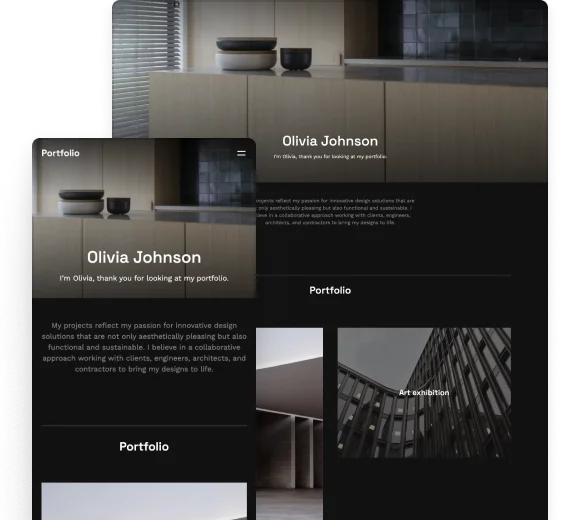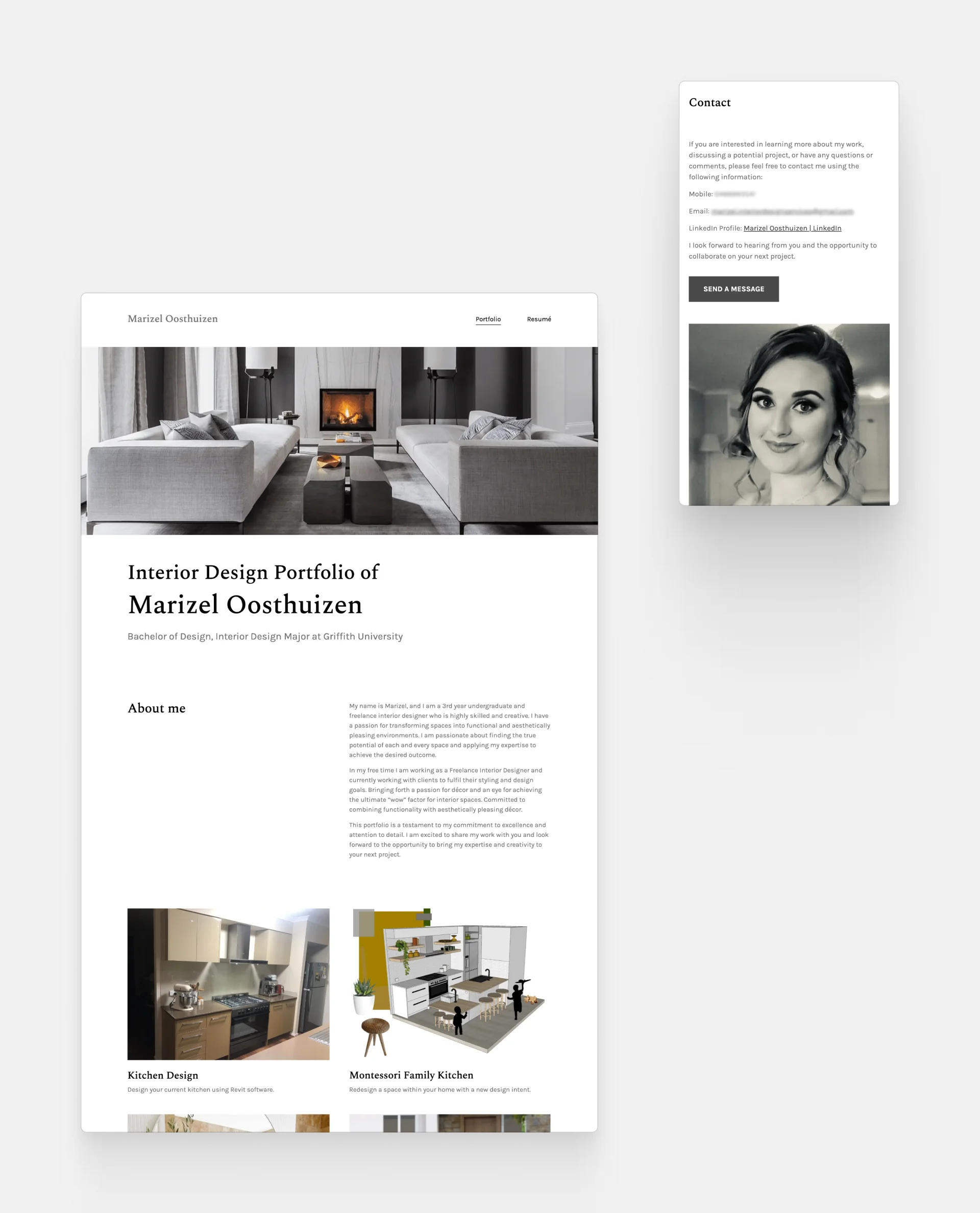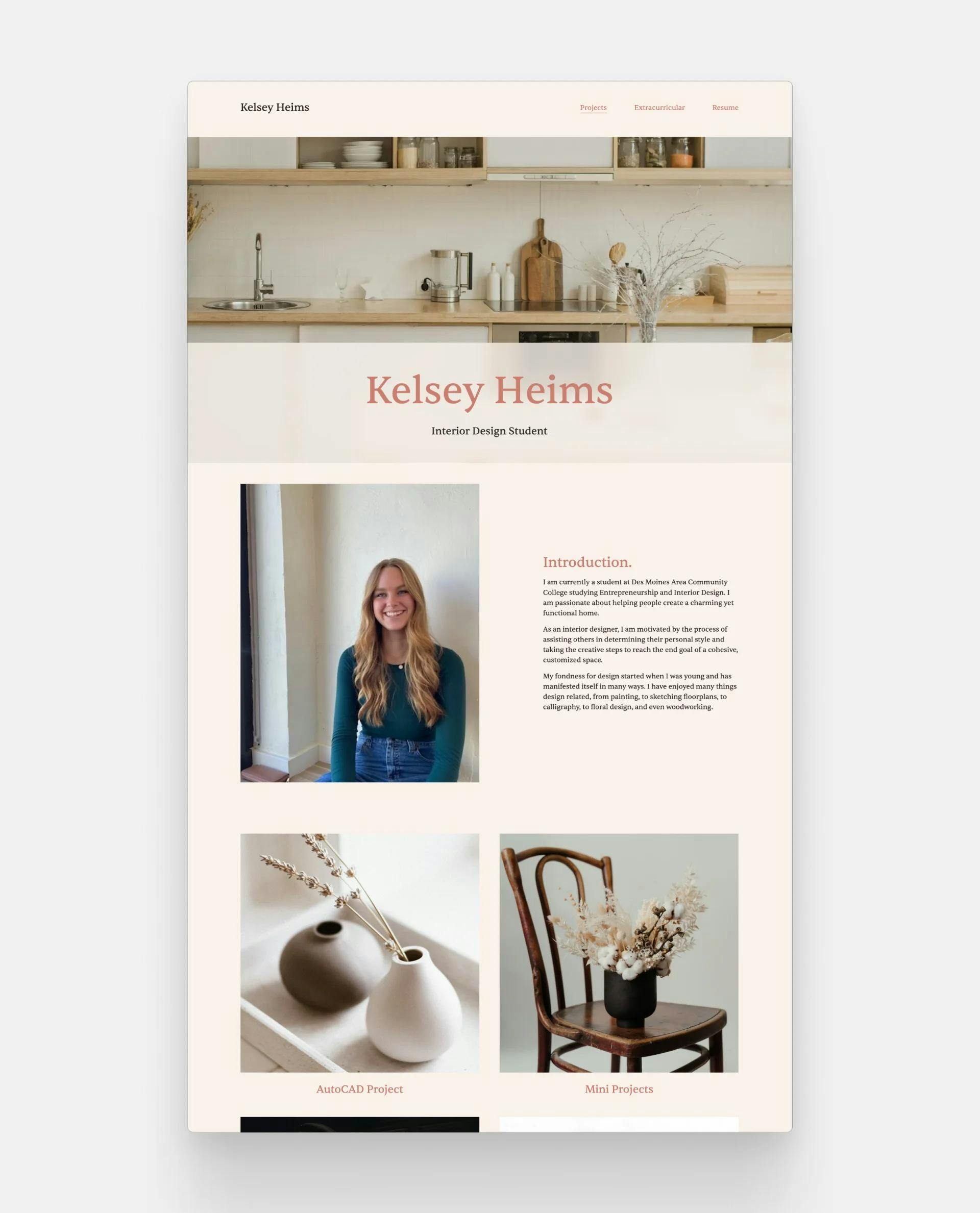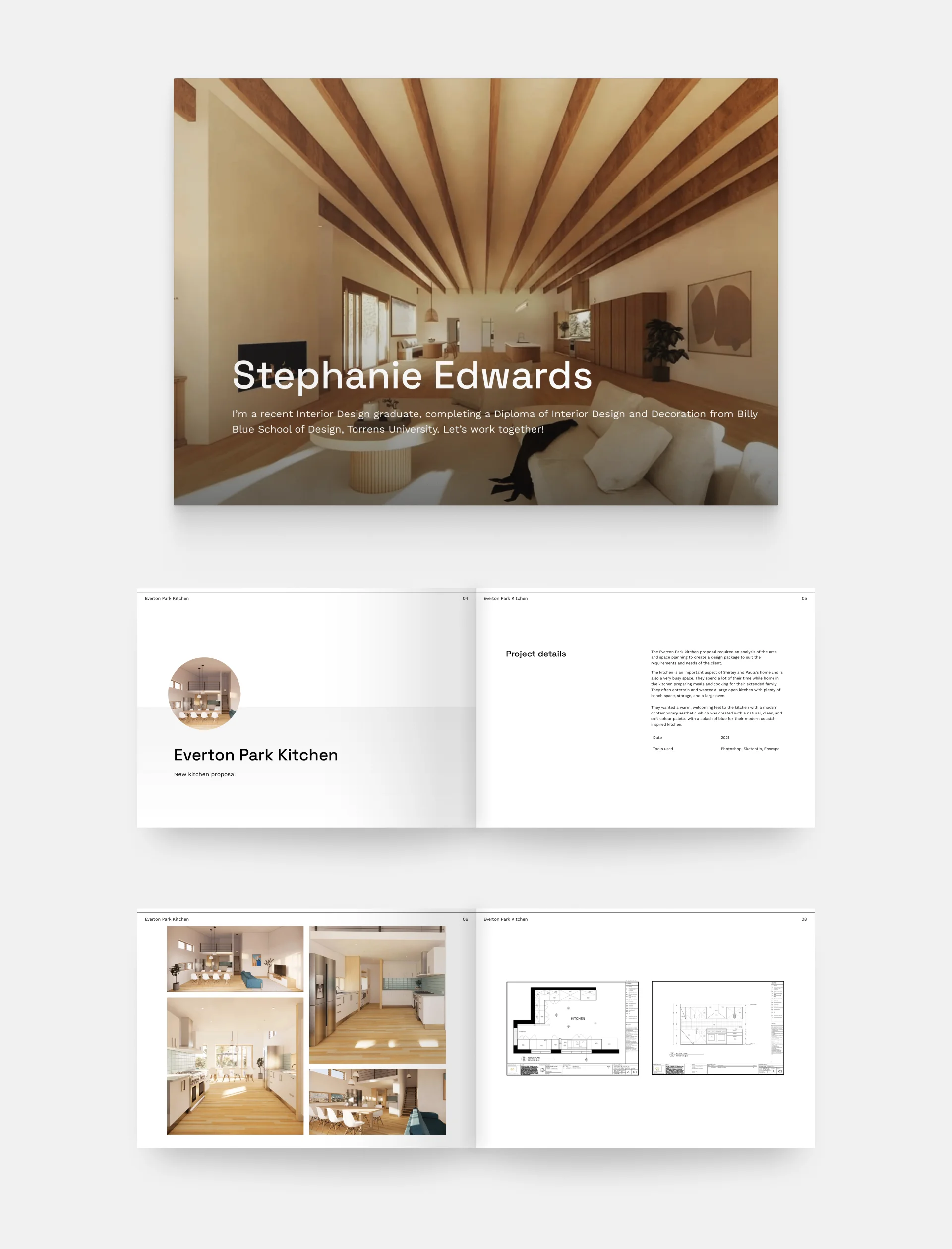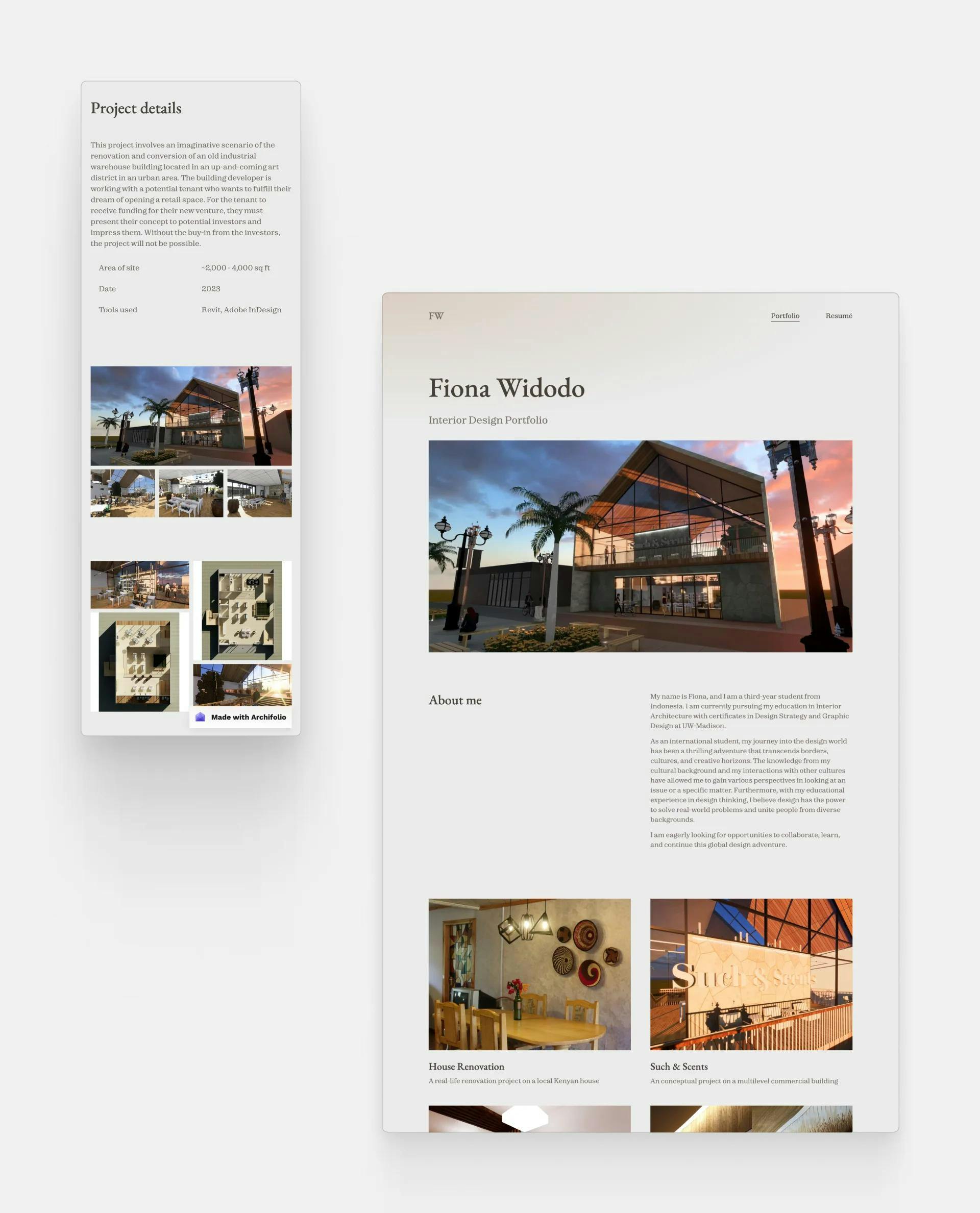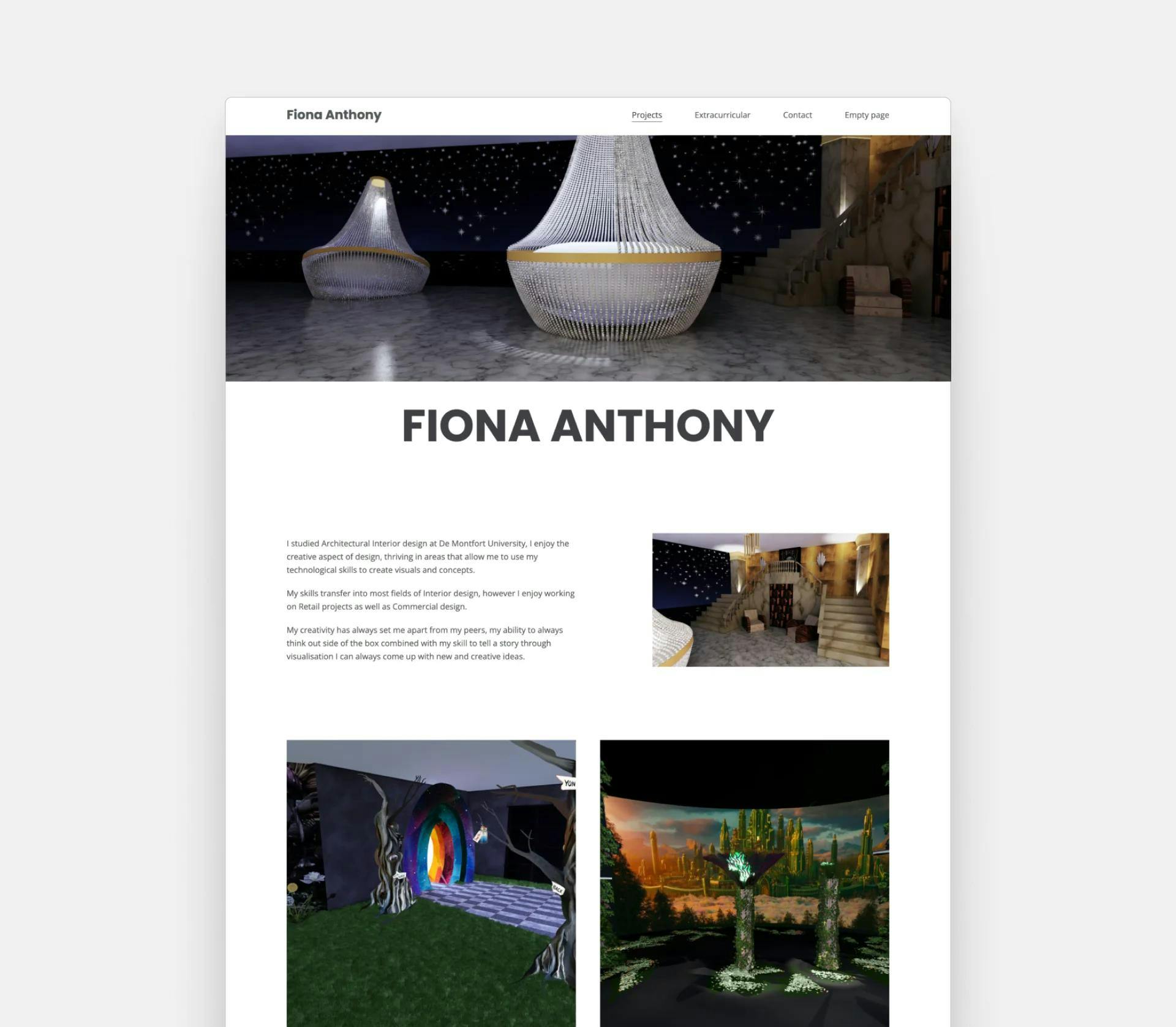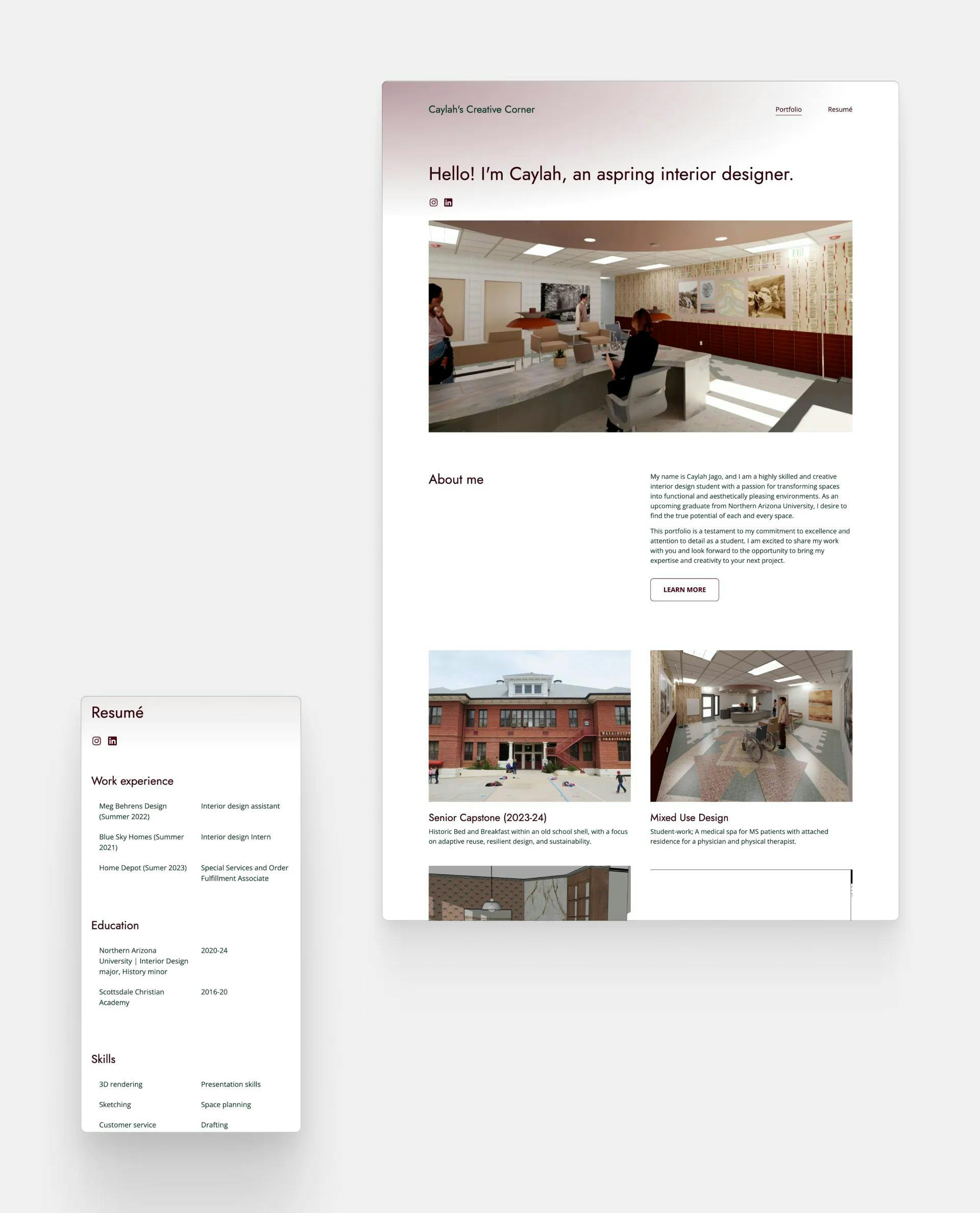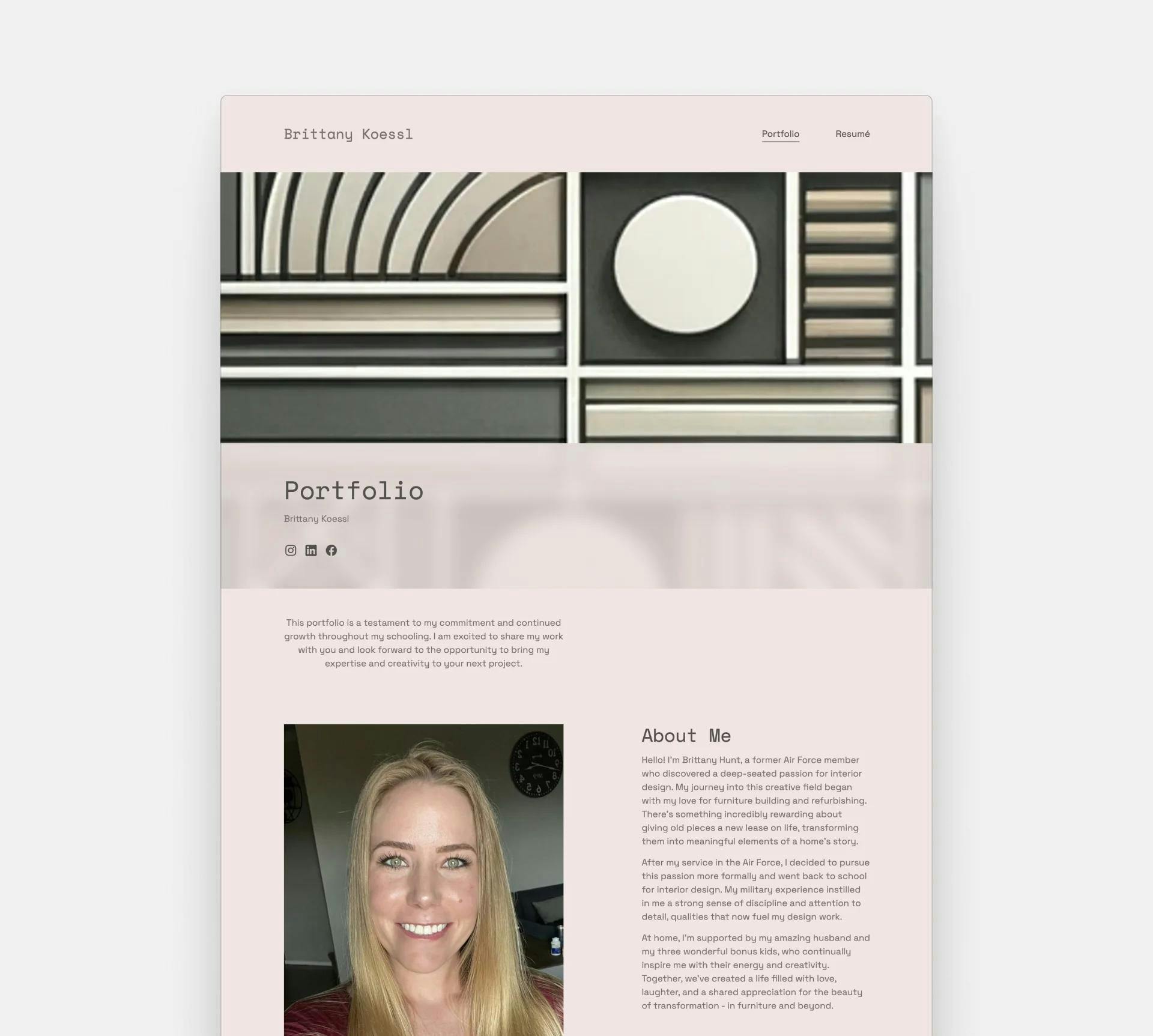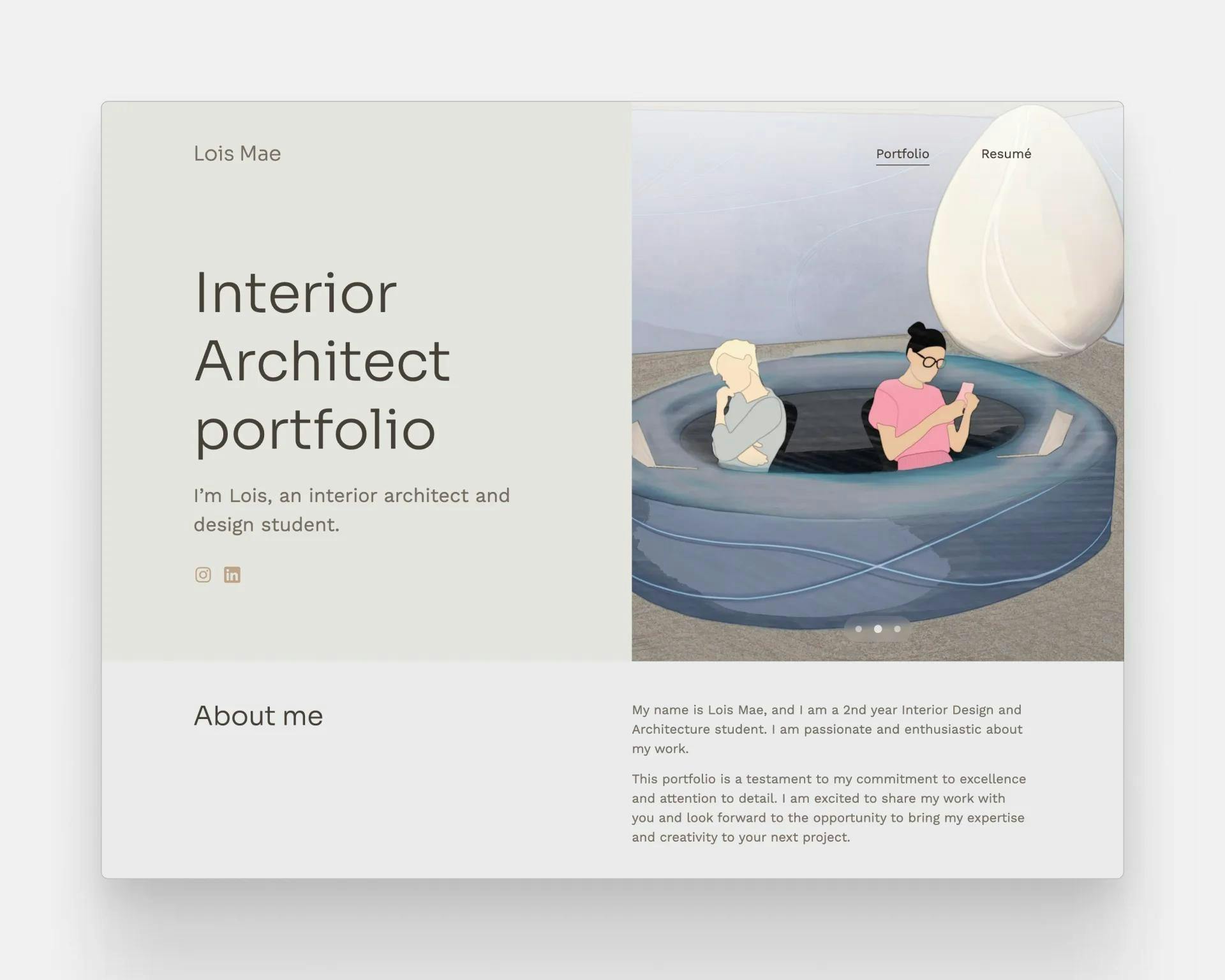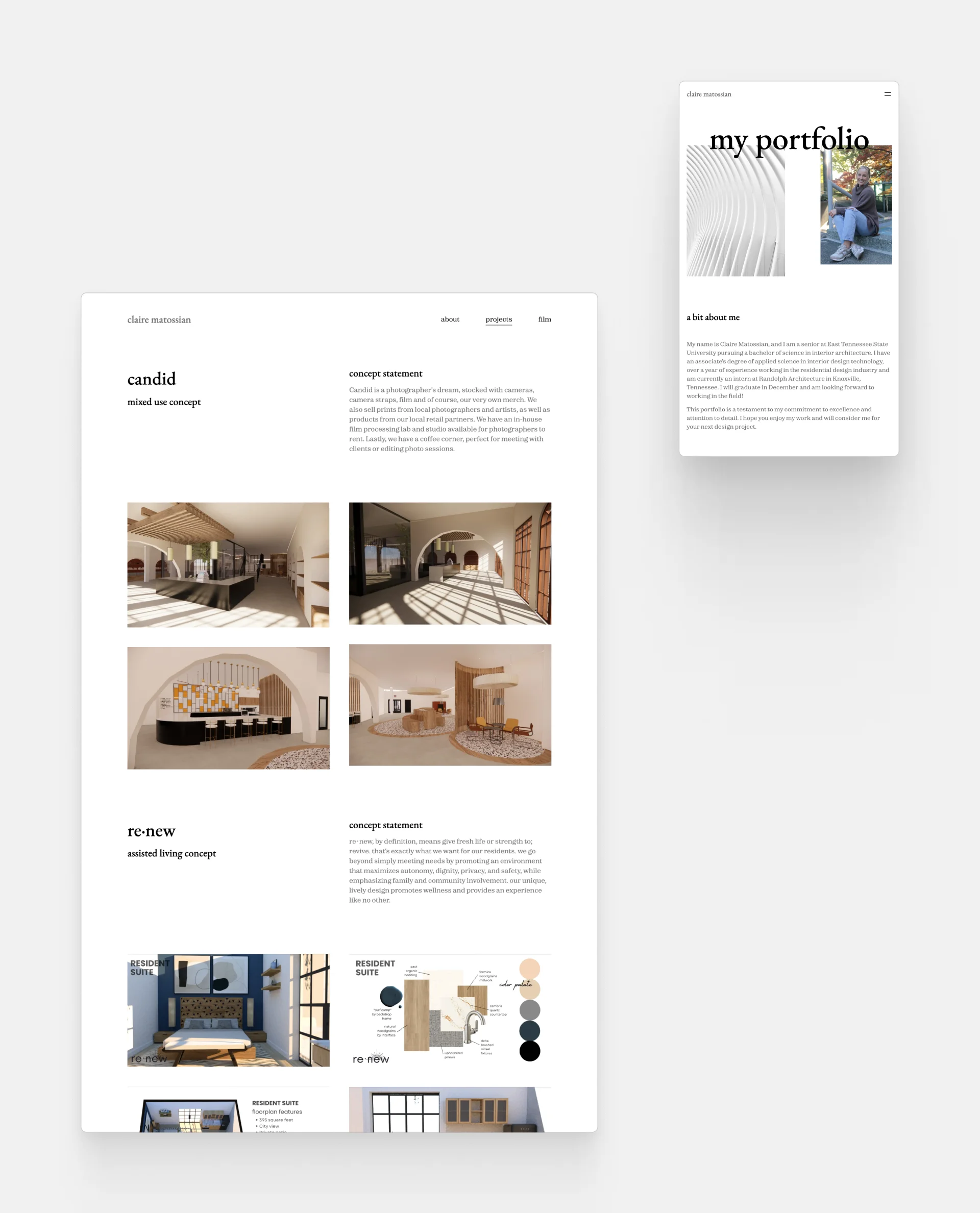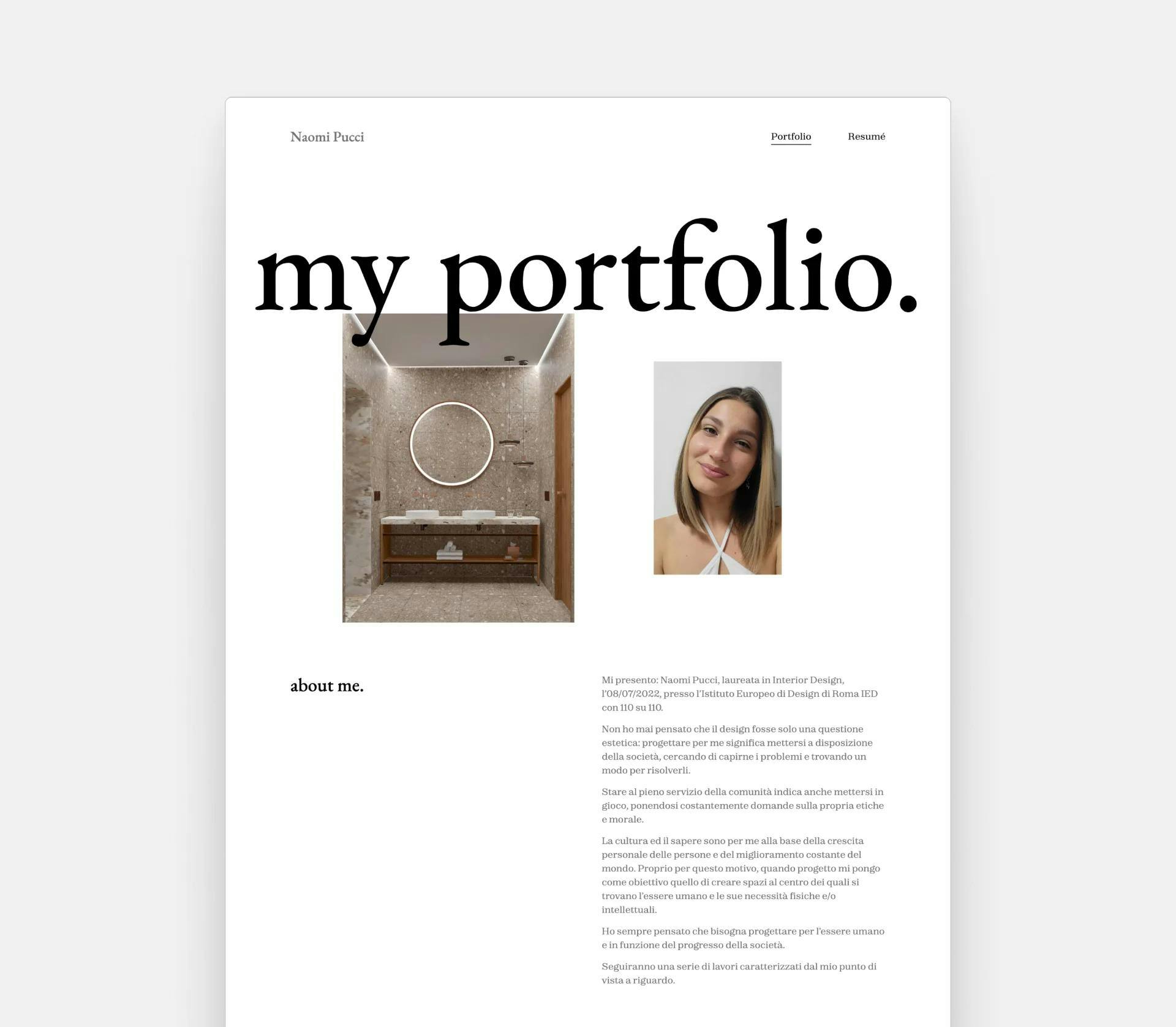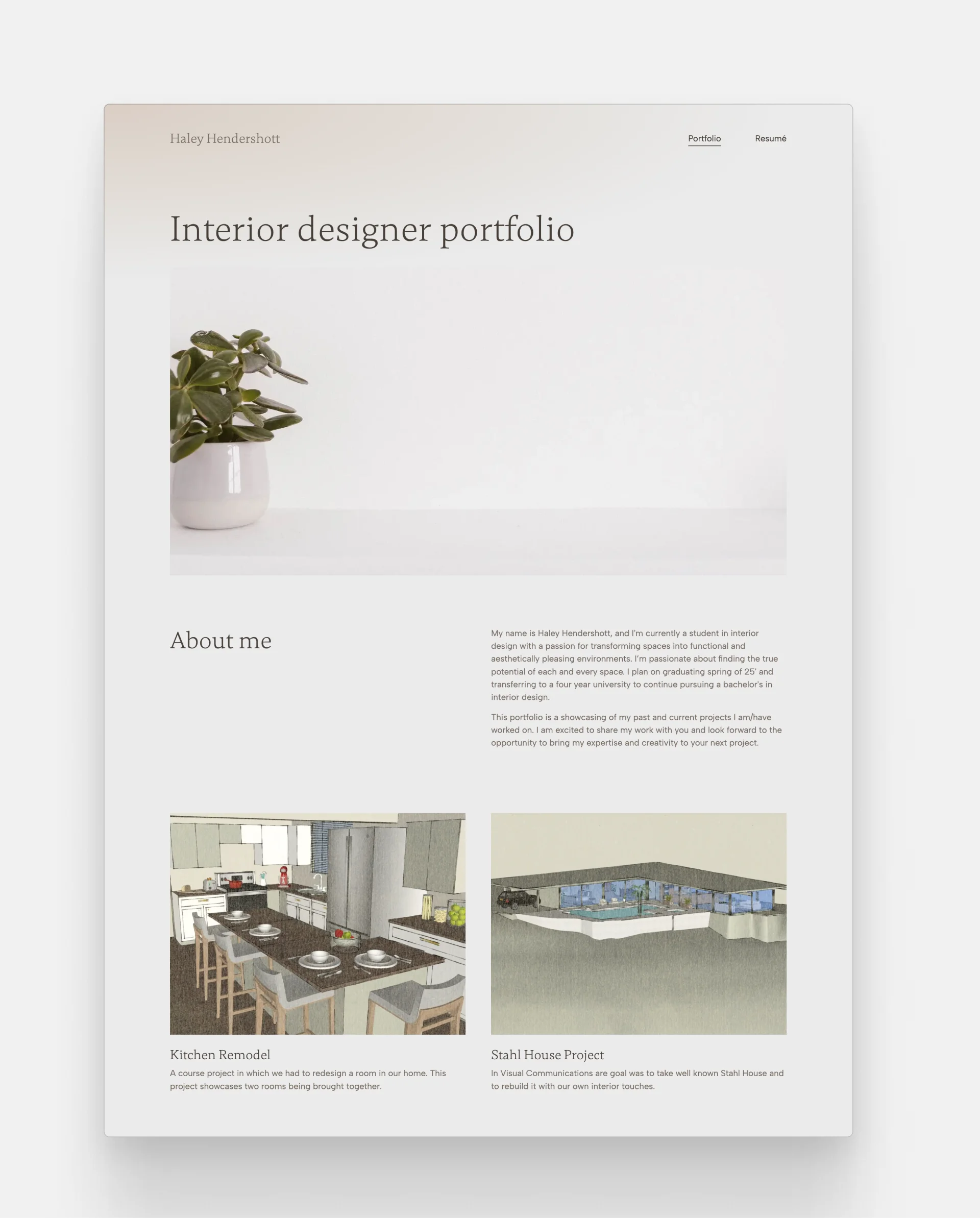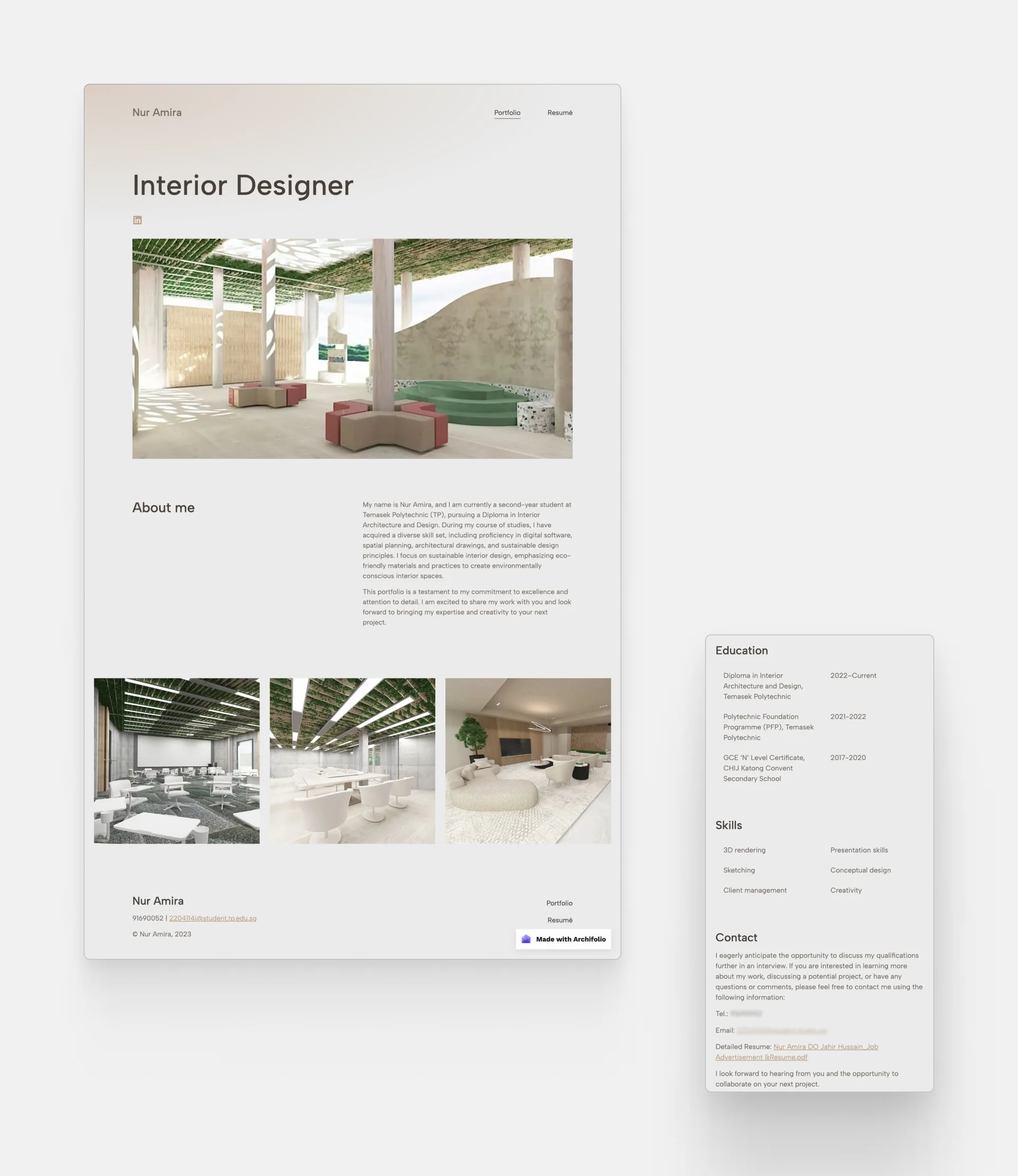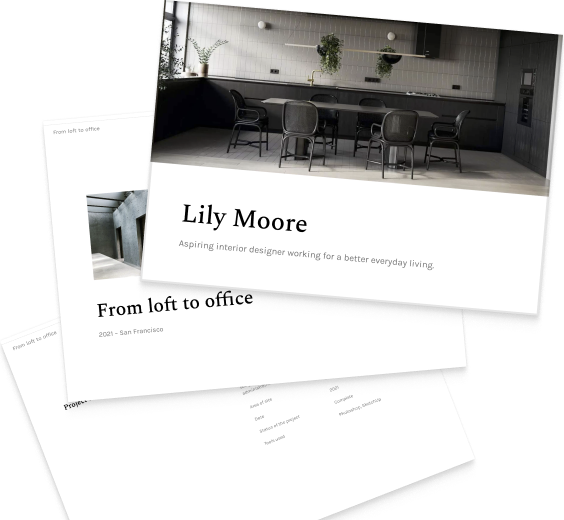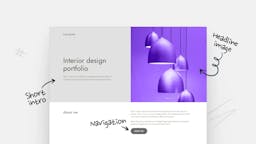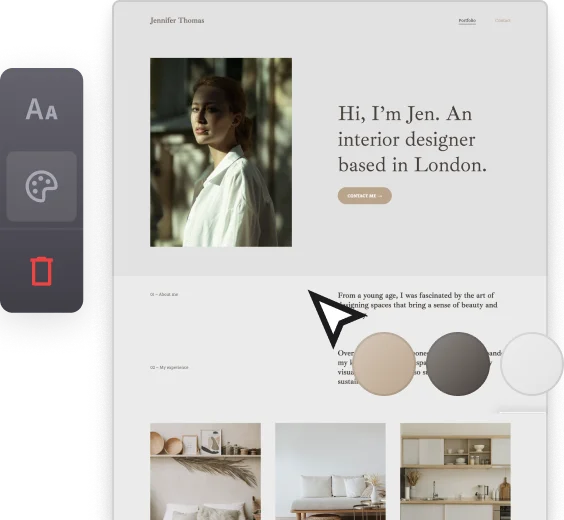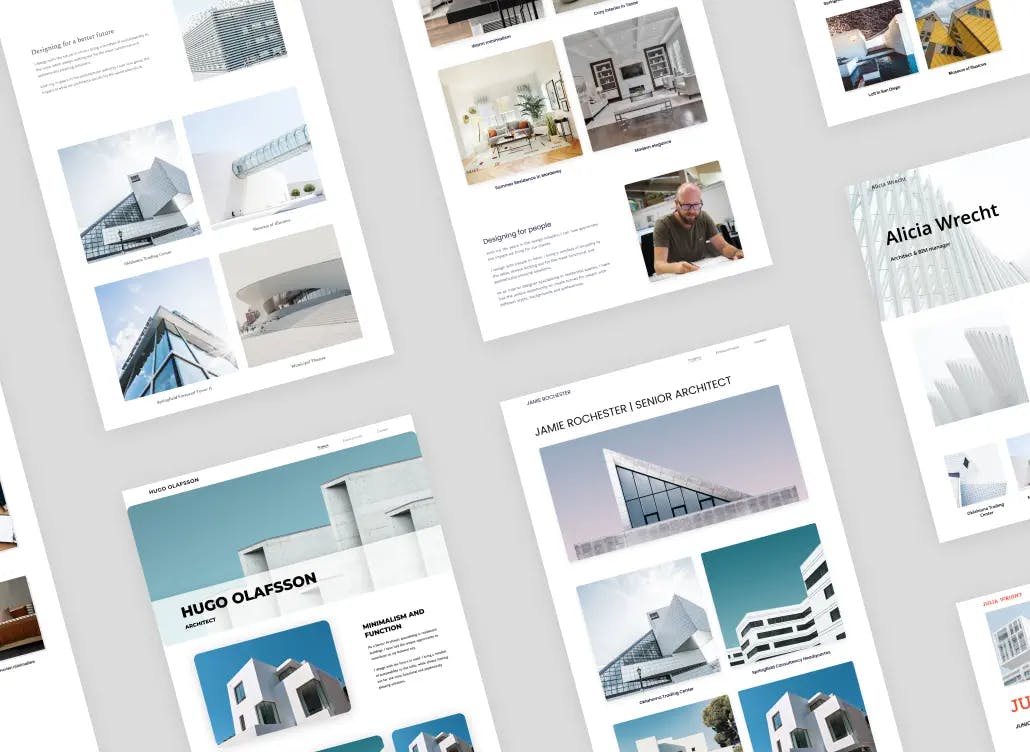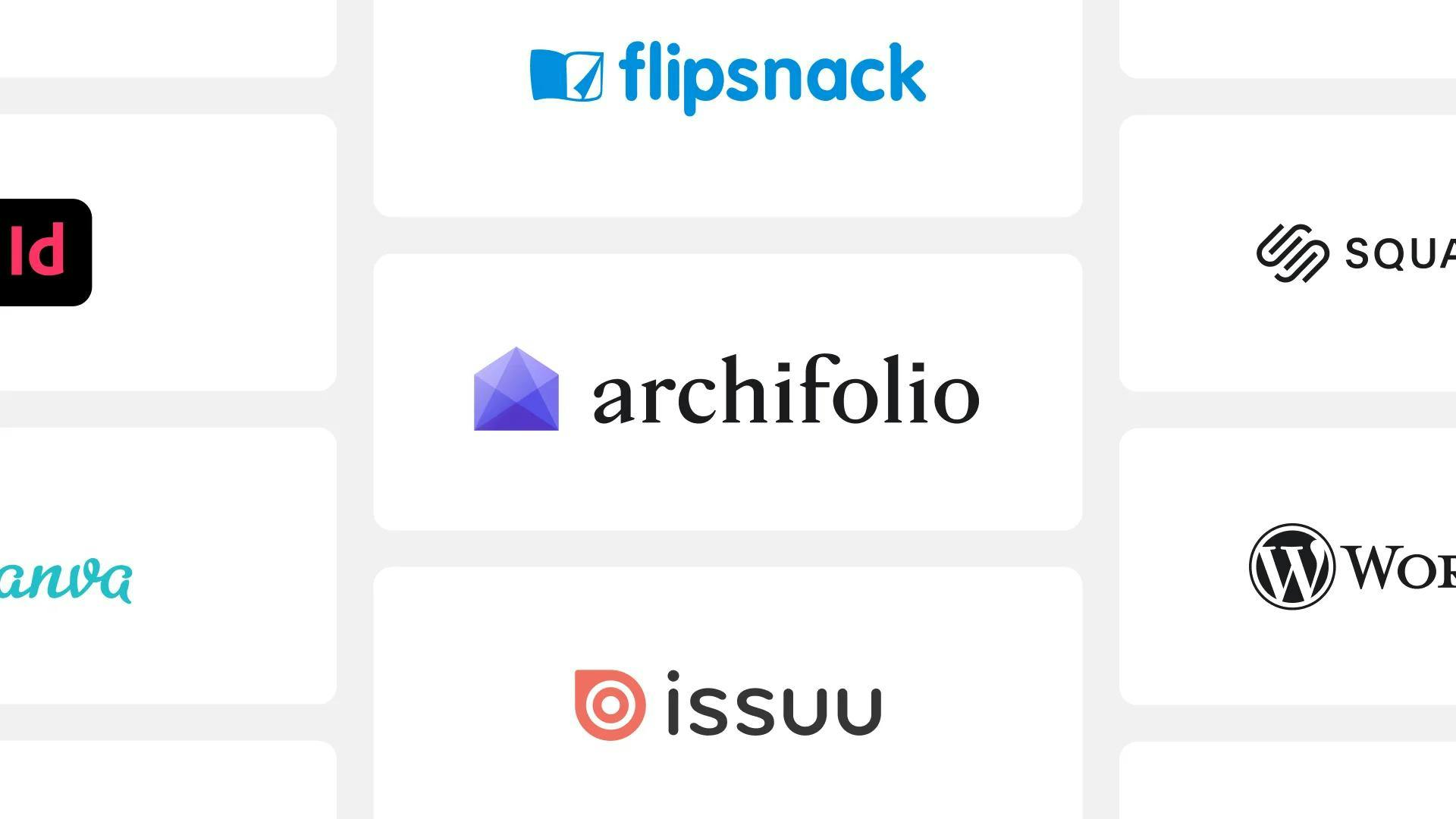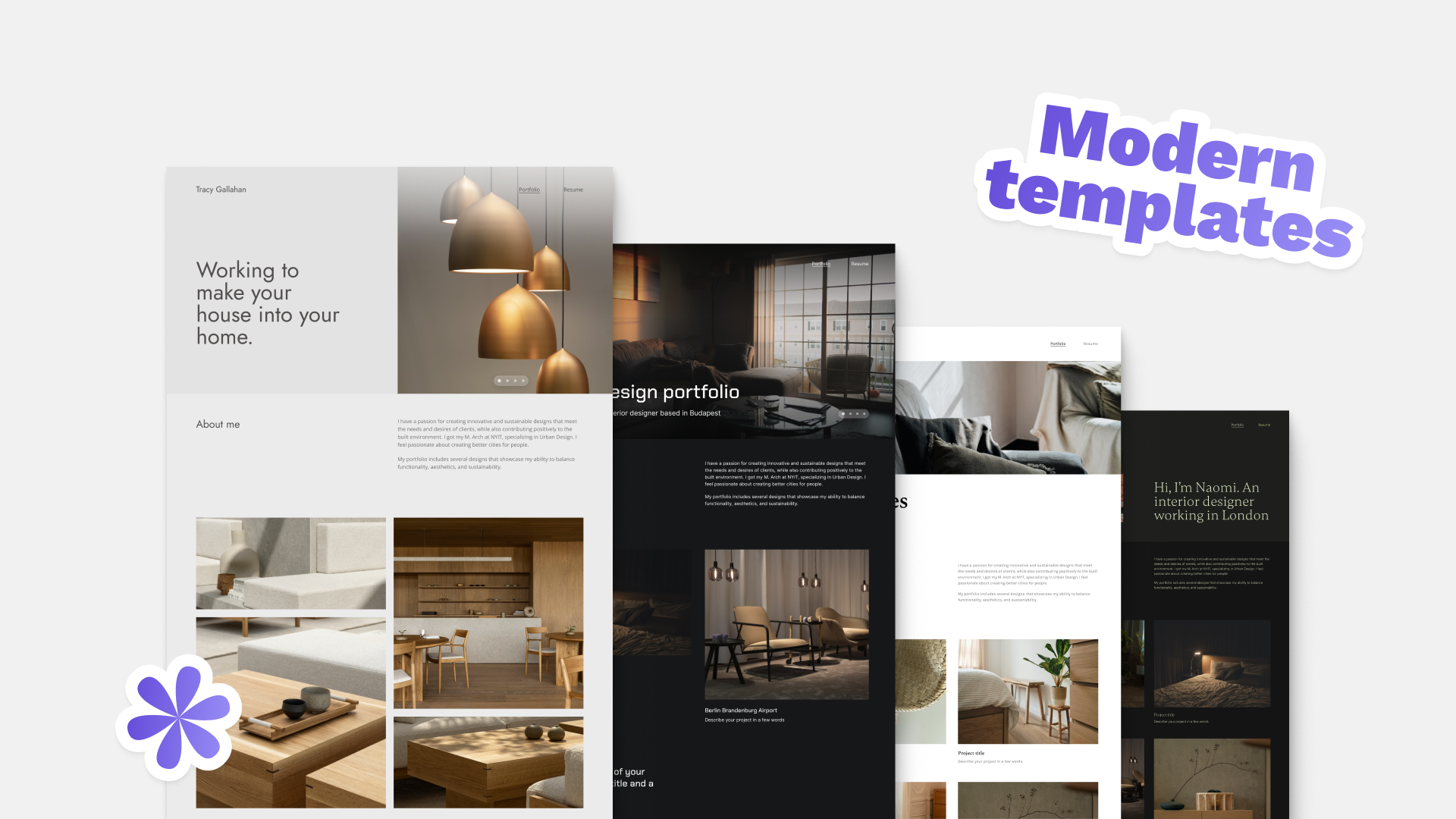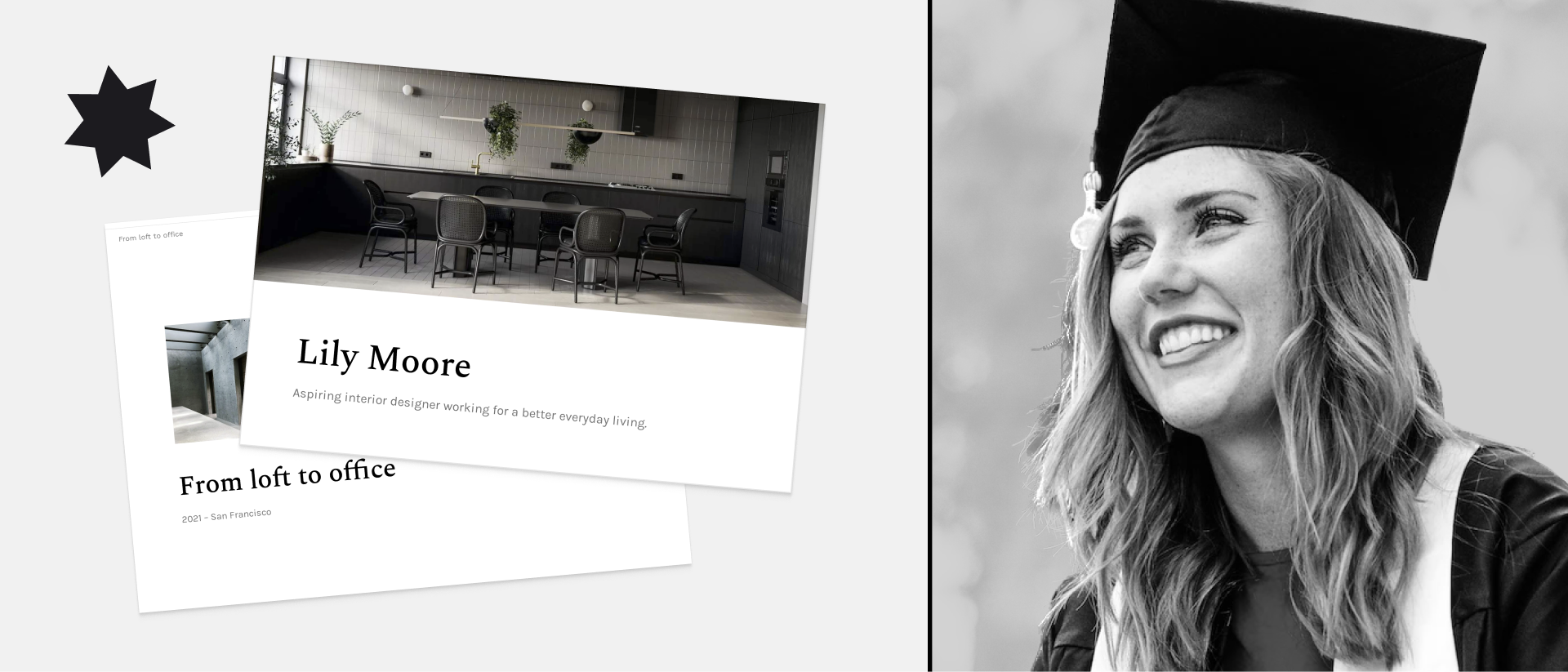
Step-by-step Guide for Creating Your Interior Design Student Portfolio (+10 Examples)
There are roughly 62.000 interior designers in the US. They work in different niches, have different styles and approaches. But they do have one thing in common: they all started somewhere.
You may only be at the beginning of your career, but nevertheless, you need an interior design student portfolio to get you started. And in this article, the team of Archifolio walks you through creating it step by step.
10 Interior Design Student Portfolio Examples
Inspiration does exist, but it must find you working.
As step zero in your portfolio creation process, you’ll most likely want to see some examples. What worked for others? What didn’t? Is there anything that resonates with you?
So we’ve gathered the 10 best examples below to get your creative juices flowing.
1. Marizel Oosthuizen
Marizel's elegant portfolio
Marizel's portfolio makes any recruiter's job a breeze. She starts with a cozy yet refined image of a living room interior—setting the perfect tone for what's to come. Then, talks about her experience and introduces herself professionally. Afterward, she dives into her projects right away, which makes checking out her well-structured projects effortless.
Template: Agora from Archifolio
2. Kelsey Heims
Kelsey Heim's welcoming portfolio
Kelsey's portfolio is an inviting space, where you're greeted with a big smile and stunning projects. Her beige, warm color palette and impressive visuals draw you in to see more. We love the way she structured her work and showcased her extracurricular projects as well.
Template: Chapter from Archifolio
3. Stephanie Edwards
Stephanie Edwards' interior design portfolio—created with Archifolio
Stephanie—as a recent interior design graduate—created an impressive portfolio that works both as a website and a PDF. She catches our attention with a striking render right at the beginning. The visible beams in the interior drive our eyes to her name and short introduction.
Template: Museum by Archifolio
4. Fiona Widodo
Fiona Widodo's impressive portfolio
This portfolio by Fiona perfectly captures her international design journey and her never-ending inspiration. We adore the way she gives us a glimpse into her design abilities by showcasing her range—she included architectural plans, 3D floor plans, computer renders, hand renderings, before-after images, graphic design, and sketches.
Template: Palazzo by Archifolio
5. Fiona Anthony
Fiona Anthony's mystical interior design portfolio website
Fiona's out-of-the-box thinking and creativity make her stand out from the crowd, which is perfectly represented in her interior design student portfolio. She has a minimalist design mixed with her mystical and detailed renders, which create a space that's ready to sweep recruiters off their feet.
Template: Agora from Archifolio
6. Caylah Jago
Caylah Jago's extraordinary interior design portfolio
We're amazed by how effectively Caylah introduces her projects in her interior design portfolio. She included some stunning project images as thumbnails that intrigue us enough to check out the next one—and then the next one. She also showcases her background and interior design skills successfully in her straightforward resume.
Template: Palazzo by Archifolio
7. Brittany Koessl
Brittany Koessl's sophisticated portfolio
Brittany created a superbly elegant portfolio thanks to the abstract hero image and the pastel pink background. We love the way she makes a great first impression by introducing herself in an "About me" paragraph and a friendly yet professional portrait of herself.
Template: Chapter by Archifolio
8. Lois Mae
Lois Mae's intriguing portfolio
We adore the way Lois introduced their unique way of thinking by including hand renderings right in the website's hero. They follow this with a professional introduction, which gives all the relevant information to the recruiters. They also included their social media links, which is a nice touch and a sneaky way of presenting more of your work without overwhelming the viewers.
Template: Loft by Archifolio
9. Claire Matossian
Claire Matossian's unique portfolio
Claire's portfolio reflects the fresh perspective of a soon-to-be graduate. Her bright and airy layout not only showcases her design skills but also gives a glimpse into her aesthetic preference. Apart from her interior architecture projects, Claire brings a personal touch by incorporating her film photography projects into her portfolio for a well-rounded presentation.
Template: Downtown by Archifolio
10. Naomi Pucci
Naomi Pucci's stellar portfolio website
Naomi's student interior design portfolio is a promising start to her career. Her aesthetic style shines through the home page with an enticing render and a professional introduction. In the first few paragraphs, she talks about her mission statement and why she embarked upon her journey as an interior designer.
Template: Downtown by Archifolio
11. Haley Hendershott
Haley Hendershott's polished portfolio
The colors, images, and layout in Haley's portfolio website effortlessly communicate their sustainable approach to design. The earthy tones and clean layout create an atmosphere, where her projects can shine.
Template: Archifolio's Palazzo
12. Nur Amira
Nur Amira's sleek interior design portfolio
Nur's portfolio layout is straightforward and minimal yet captivating. Her render-heavy home page intrigues us to see more. When we navigate over to the Resume page, we're greeted with a simple, easily digestable CV layout.
Template: Palazzo by Archifolio
We hope these interior design portfolio examples gave you the inspiration you needed. Are you ready to dive in?
How to Make an Interior Design Student Portfolio?
Before jumping into designing your portfolio you first need to:
1. Think about who will see your portfolio
You may create your first-ever interior design portfolio to get into university. In that case, think about what the admission officers are interested in a potential student.
If you are creating your student portfolio as an undergraduate to land your first internship, you’ll have to understand what companies are expecting from interns and what makes them want to hire one.
2. Gather your materials
This might be tedious, but you have to look at all of your materials that you’ve created so far. If you are an undergrad and already have dozens of designs, make sure to collect and organize them. If you are applying to go to college and don’t yet have any interior design related projects, collect your artworks and drawings so that you can show your creativity.
Get in the habit of documenting your design process. Scan your sketches or hand renderings as soon as possible. It’s a good idea to document them even when they are half-finished, as raw sketches show your interior design skills and thought processes best.
Now, let’s explore further how you can create your interior design student portfolio for college.
How to create a portfolio for college?
Creating your first-ever portfolio is a difficult task. Chances are that you have doubts about what format to choose, which projects to include and how long it should be. But don’t worry, we brought you our recommendations to make this process easier. In only 5 easy steps you’ll have a portfolio that you can be proud of.
Step 1. Study the requirements carefully
First and foremost, it’s crucial to adhere to the requirements of the university if you are creating your interior design student portfolio for college. Sure, creativity is about thinking outside the box, however, if you break the rules too much, the admissions office might not even look at it.
Secondly, forget about creating one portfolio and sending it to all the colleges out there. Each university has different requirements, focus and priorities. When it comes to interior design portfolios, one size does not fit all.
Step 2. Choose the right format
Different formats work best for different purposes. If the university doesn’t specify exactly what format you should go with, then you can choose from these 3 main options:
- a website,
- a PDF, or
- a hard copy.
Having an interior design website as your master portfolio is a great idea. You don’t have to worry about the file size limitations and therefore, you can store all of your projects in one place. Plus, you can share it easily with a professional link (e.g. yourname.com). However, many universities want to print the portfolios that they receive, and thus, having a PDF sample is often required.
If you want to get both, create your portfolio with Archifolio. You’ll get an intuitive website builder with unlimited storage, and easy access to examples and guides. When you're done, you can simply export it as a PDF with the most important projects and then, you're left with your portfolio sample.
We make portfolio building effortless, so that you can focus on what really matters.
A template can save you loads of time and energy.
Line spacing, margins, fonts and colors. These are all crucial factors in any portfolio. But setting them one by one on all of your pages is a pain in the neck. Plus, unless you have unlimited time and patience, you’ll end up with a few inconsistencies that will make your portfolio feel a bit off. So we advise you to work smarter, not harder and use an interior design portfolio template. It will ensure you have the basic design principles down and afterward you can (and should) make it your own to show your style and personality.
Style is a way to say who you are without having to speak.
Step 4. Showcase the right projects
If you are creating your portfolio to apply to master studies, choosing which academic projects make it into your portfolio and which ones don’t can be tough. But if you ask yourself the following questions, you’ll have no trouble.
- What’s the university’s profile? Do you have projects that fit it?
- What skills do you want to showcase in your portfolio? Which projects show them the most?
- For which projects do you have the right amount of documentation (e.g. initial sketches, mood boards, digital and hand renderings)?
What needs to be in a student interior design portfolio?
The structure of a student portfolio is quite straightforward. It's similar to any creative field, so you may get inspired by architecture student portfolios as well.
- You start with a portfolio cover or homepage (depending on your format),
- continue with a resume or an introduction,
- then you introduce your project (with a title page or thumbnail image),
- and then you have your project page (with a brief description of the project and a walk-through of your design process).
And then you repeat steps 3 and 4 for your additional projects.
On your project pages your main goal should be to tell a story. This might seem like a difficult task, but we have a tried and true formula that will make it easy for you.
- Give a title to your project. It may seem self-explanatory, but it’s just as crucial since your audience needs a way to refer to it later on.
- Start with an image of the end-result. This can be your best render, or something that gives your audience an idea of what kind of project they are about to see.
- Write at most two sentences about your project to give context.
- Summarize the most important details of your projects in a bulleted list (e.g. your role in the project, size and type of the real estate (residential, commercial, hospitality etc), and the interior design softwares you used to finish the project)
- Include your inspiration or mood board,
- Add your initial sketches,
- Then come your floor plans and your interior elevations,
- And finally, add your renders, CAD designs and construction drawings.
When you start building your portfolio in Archifolio, you’ll find that these (and many more) recommendations are built into our tool. So, you won’t stare at the blank page for long minutes thinking about what to write. Instead you have the option to follow our tried-and-tested recipe and create your portfolio in no time!
And you’re done! Now that you have the basics down, let’s look at how you can stand out from the crowd and get accepted, shall we?
What Makes a Good Interior Design Student Portfolio?
Imagine that you are in charge of university admissions. You need to look at hundreds of portfolios and determine which candidates get accepted and which don’t. What would you look out for?
Firstly, you probably wouldn’t have too much time to assess the portfolios. So, you’d appreciate those that are skimmable, easy to read and navigate in.
Then you’d probably screen the portfolios based on certain aspects and only give a second look to fewer.
Other than having the hard skills and meeting the average standards, what would make you want to admit students? Most likely creativity, eagerness to learn and passion in the interior design field.
On the other hand… What would make you throw the portfolio in the “no” pile? Too few projects or bad quality images could be the reason. But also typos, bad grammar, and spelling indicate that the person creating the portfolio either does not care enough to proofread what they wrote or isn’t paying attention to the details.
What can you do?
So, now that you have thought about how it will be evaluated, you’ll see how you can make an awesome portfolio:
- Make it easy to navigate.
- All written content should be skimmable (use bullet lists and make important information bold).
- Show your willingness to learn and your interest in interior design.
- Pay attention to grammar and spelling and ask someone to proofread it for you.
- Make the first impression a good one (by using your best images upfront or creating a superb cover).
- Showcase your skills in your projects.
- Tell a story with your designs.
- Show your personality (e.g. include your artworks that don’t have anything to do with interior design)
- Keep it simple.
Simplicity is about subtracting the obvious and adding the meaningful.
Now there’s only one thing left to do: Getting started! With Archifolio, you can create your own portfolio website in a matter of minutes. No coding skills needed with our intuitive what-you-see-is-what-you-get editor. Just upload your content and make it your own!
